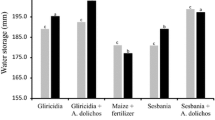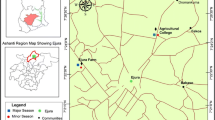Abstract
There are abundant local legume trees and shrubs potentially suitable for alley cropping systems in the sub-Saharan Africa, which are yet to be studied. The nitrogen contribution of two years old Albizia lebbeck and S. corymbosato yield of maize grown in alley cropping was compared to that of Senna siamea, Gliricidia sepium and Leucaena leucocephala in four seasons at Ibadan. Maize shoot biomass and maize grain yield in A. lebbeck alley compared favourably with that in G. sepium and L. leucocephala. Maize biomass and grain yield in S. corymbosa alleys were the lowest. Within A. lebbeck, L. leucocpehala, and G. sepium alleys there were no significant differences in the maize yield in the alleys that received 0, 40 or 80 kg N/ha. Application of more than 40 kg N/ha in S. corymbosa alleys was not necessary as there was no significant increase in maize yield at the higher level of nitrogen. Maize yield and N uptake in A. lebbeck alleys were not significantly different from yield and N uptake in G. sepium, and L. leucocephala at the same fertilizer level. There was a significant correlation between hedgerow tree biomass and maize grain yield. At the end of twelve weeks after pruning application, the organic residues of the pruning applied in the alleys ranged from 5% in G. sepium and 44% in A. lebbeck in the first year compared with the original pruning applied which showed that the slow rate of A. lebbeck decomposition could have a beneficial effect on the soil. The maize N recovery from applied N fertilizer was low (10–22%). Percentage N recovery from the prunings was low in the non-N fixing trees (12–22%), while the recovery was high (49–59%) in A. lebbeck as well as in the other nitrogen fixing tree prunings. Thus A. lebbeck, apart from enhancing maize growth and grain yield like in L. leucocephala and G. sepium, had an added advantage because it remained longer as mulching material on the soil because of its slow rate of decomposition. It was able to survive pruning frequencies with no die-back. This indicates that A. lebbeck is a good potential candidate for alley cropping system in West Africa. S. corymbosa performed poorly compared with the other legume trees. Though it responded to N fertilizer showing a positive interaction between the hedgerow and fertilizer application, it had a high die back rate following pruning periods and termite attack.
Similar content being viewed by others
References
Bailey LH (1949) Manual of cultivated plants. Macmillan Publishers Co Inc, New York, 1116 pp
Bangarwa KS, Singh RR and Kumar R (1991) Survival of different tree species in Arid India. Nitrogen Fixing Tree Research Reports (NFTRP) 9: 3
Duguma B (1985) Studies on factors affecting establishment of selected tree species of poten-tial importance in agroforesry. PhD Thesis, 412 pp
Giller KE and Cadisch G (1995) Future benefits from biological nitrogen fixation. An ecolog-ical approach to agriculture. Plant and Soil 174: 255–277
Genstat 5.3 Statistical Package (1993)
International Institute of Tropical Agriculture (IITA) (1985) IITA Research Highlights
International Institute of Tropical Agriculture (IITA) (1989) Analytical Manual IITA, Ibadan, Nigeria
International Institute of Tropical Agricutlure (IITA) (1992) IITA Weather Bulletin 1992
International Institute of Tropical Agriculture (IITA) (1993) IITA Weather Bulletin 1993
Kang BT, Grimme H and Lawson TL (1985) Alley cropping sequentially cropped maize and cowpea with Luecaena on a sandy soil in Southern Nigeria. Plant and Soil 85: 267–277
Kang BT, Reynolds L and Attah-Krah AN (1990) Alley farming. Adv Agron 43: 315–359
Kang BT, Sipkens L, Wilson GF and Nangju D (1981) Leucaena leucocephala (Lam) de wit) prunings as nitrogen source of maize (Zea mays L.). Fertilizer Research 2: 279–287
Kumar N and Toky OP (1994) Variation in chemical contents of seeds, and foliage in A. lebbeck (L) Benth. of different provenances. Agroforestry Systems 25(3): 217–225
Lowry JB and Lowry JBC (1991) Canopy growth of A. lebbeck in the semi arid tropics. Nitrogen Fixing Trees Research Reports (NFTRP) 9:3
Mafongoya PL, Giller KE and Pal CA (1998) Decomposition and nitrogen release patterns of tree prunings and litter. Agroforestry Systems 38: 77–97
Melilo JM, Aber JD and Muratore JF (1982) Nitrogen and Lignin control of hardwood leaf litter decomposition dynamics. Ecol. 63: 621–629
Moorman FR, Lal R and Juo ASR (1975) The soils of IITA. IITA Technical Bulletin No 3, 48 pp
Mulongoy K and Van der Meersch MK (1988) Nitrogen contribution by leucaena (Leucaena leucocephala) prunings to maize in an alley cropping system. Biol Fertil soils 6: 282–285
Okogun JA, Mulongoy K, Odu CTI and Agboola AA (1994) Screening of multipurpose trees for alley cropping on Alfisols and Ultisols. In: Sadiki M and Hilali A (eds) pp 550–562. Recent Developments in Biological Nitrogen Fixation in Africa. Proceedings of the fifth international conference of the Association for Biological Nitrogen Fixation (AABNF) Rabat Morocco
Palm CA (1995) Contribution of agroforestry trees to nutrient requirements of intercropped plants. Agroforestry Systems 30: 105–124
Sanginga N, Mulongoy K and Ayanaba A (1988) Nitrogen contribution of L. leucocephala/ Rhizobium symbiosis to soil and a subsequent maize crop. Plant and Soil 112: 137–141
Sanginga N, Mulongoy K and Ayanaba A (1988) Response of L. leucocephala/Rhizobium symbosis to nutrients in Southwestern Nigeria. Plant and Soil 112: 121–127
Stokes BJ (1972) Organic Chemistry. Edward Arnold Publishers. London, 517 pp
Tian G, Kang BT and Brussaard L (1993) Mulching effect of plant residues with chemically contrasting compositions on maize growth and nturients accumulation. Plant and Soil 153: 179–187
Tossah KB, Tossou YH and Tamelokpo A (1995) Alley Farming Research in Togo. In: Alley Farming Research and Development Proceedings of the International Conference on Alley Farming Ibadan 1992, pp 261–267
Vanlauwe B, Sanginga N and Merckx R (1997) Decomposition of four Leucaena and Senna prunings in alley cropping systems under sub-humid tropical conditions: the process and its modifiers. Soil Biol Biochem 29(2): 131–137
Zapata F (1988) Isotope techniques in soil fertility and plant nutrition studies. In: Hardarson G (ed) The use of nuclear techniques in studies of soil/plant techniques A training Manual, pp 36–112. International Atomic Energy Agency (IAEA) Laboratories, Seibersdorf, Austria
Author information
Authors and Affiliations
Corresponding author
Rights and permissions
About this article
Cite this article
Okogun, J.A., Sanginga, N. & Mulongoy, K. Nitrogen contribution of five leguminous trees and shrubs to alley cropped maize in Ibadan, Nigeria. Agroforestry Systems 50, 123–136 (2000). https://doi.org/10.1023/A:1006471303235
Issue Date:
DOI: https://doi.org/10.1023/A:1006471303235




